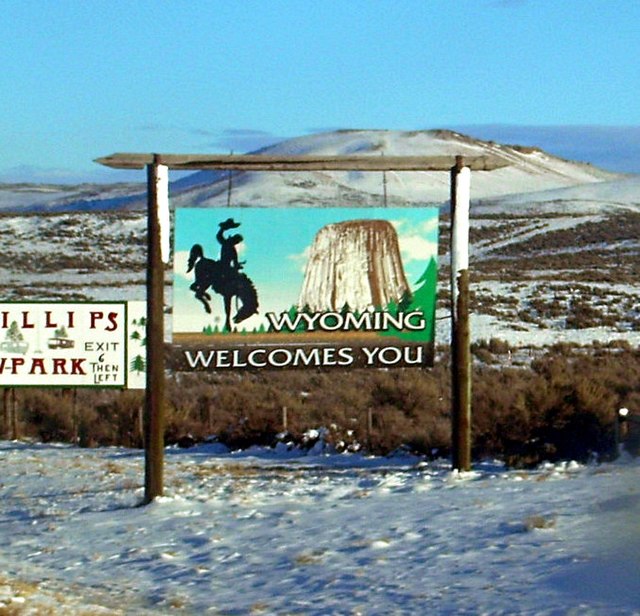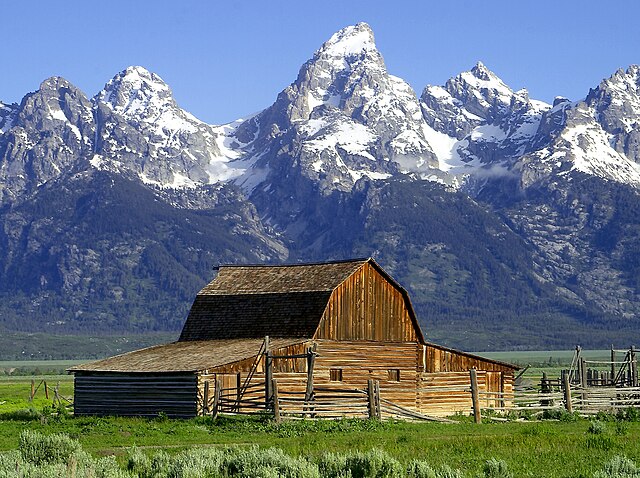Top Qs
Timeline
Chat
Perspective
Geography of Wyoming
US State Geography From Wikipedia, the free encyclopedia
Remove ads
The U.S. state of Wyoming lies in the Mountain West subregion of the Western United States and has a varied geography. It is bordered by Montana to the north and northwest, South Dakota and Nebraska to the east, Idaho to the west, Utah to the southwest, and Colorado to the south. Wyoming is the least populous U.S. state[1] and has the second-lowest population density behind Alaska.

Wyoming's western half is covered mostly by the ranges and rangelands of the Rocky Mountains, while the eastern half of the state is high-elevation prairie called the High Plains. It is drier and windier than the rest of the country, being split between semi-arid and continental climates with greater temperature extremes. Almost half of the land in Wyoming is owned by the federal government, generally protected for public uses. The state ranks 6th by area and fifth by proportion of a state's land owned by the federal government.[2] Federal lands within Wyoming include two national parks (Grand Teton and Yellowstone), two national recreation areas, two national monuments, several national forests, historic sites, fish hatcheries, and wildlife refuges.
Remove ads
Climate
Summarize
Perspective



Wyoming's climate is generally semi-arid and continental (Köppen climate classification BSk), and is drier and windier in comparison to most of the United States with greater temperature extremes. Much of this is due to the topography of the state. Summers in Wyoming are warm with July high temperatures averaging between 80 and 90 °F (27 and 32 °C) in most of the state. With increasing elevation, however, this average drops rapidly with locations above 9,000 feet (2,700 m) averaging around 70 °F (21 °C). Summer nights throughout the state are characterized by a rapid cooldown with even the hottest locations averaging in the 50–60 °F (10–16 °C) range at night. In most of the state, most of the precipitation tends to fall in the late spring and early summer. Winters are cold, but are variable with periods of sometimes extreme cold interspersed between generally mild periods, with Chinook winds providing unusually warm temperatures in some locations.[3]
Wyoming is a dry state with much of the land receiving less than 10 inches (250 mm) of rainfall per year. Precipitation depends on elevation with lower areas in the Big Horn Basin averaging 5–8 inches (130–200 mm), making the area nearly a true desert. The lower areas in the North and on the eastern plains typically average around 10–12 inches (250–300 mm), making the climate there semi-arid. Some mountain areas do receive a good amount of precipitation, 20 inches (510 mm) or more, much of it as snow, sometimes 200 inches (510 cm) or more annually. The state's highest recorded temperature is 114 °F (46 °C) at Basin on July 12, 1900,[4][5] and the lowest recorded temperature is −66 °F (−54 °C) at Riverside on February 9, 1933.[5]
The number of thunderstorm days vary across the state with the southeastern plains of the state having the most days of thunderstorm activity. Thunderstorm activity in the state is highest during the late spring and early summer. The southeastern corner of the state is the most vulnerable part of the state to tornado activity. Moving away from that point and westwards, the incidence of tornadoes drops dramatically with the west part of the state showing little vulnerability. Tornadoes, where they occur, tend to be small and brief, unlike some of those that occur farther east. The most destructive tornado to occur in Wyoming happened on July 16, 1979, in Cheyenne and caused one death and 40 injuries.[6][7]
Climate data
Remove ads
Location and size
As specified in the designating legislation for the Territory of Wyoming, Wyoming's borders are lines of latitude 41°N and 45°N, and longitude 104°3'W and 111°3'W (27 and 34 west of the Washington Meridian)—a geodesic quadrangle.[17] Due to surveying inaccuracies during the 19th century, Wyoming's legal border deviates from the true latitude and longitude lines by up to one-half mile (0.80 km) in some spots, especially in the mountainous region along the 45th parallel.[18] Wyoming is bordered on the north by Montana, on the east by South Dakota and Nebraska, on the south by Colorado, on the southwest by Utah, and on the west by Idaho. It is the tenth largest state in the United States in total area, containing 97,814 square miles (253,340 km2) and is made up of 23 counties. From the north border to the south border it is 276 miles (444 km); and from the east to the west border is 365 miles (587 km) at its south end and 342 miles (550 km) at the north end.
Remove ads
Natural landforms
Summarize
Perspective
Mountain ranges


The Great Plains meet the Rocky Mountains in Wyoming. The state is a great plateau broken by many mountain ranges. Surface elevations range from the summit of Gannett Peak in the Wind River Mountain Range, at 13,804 feet (4,207 m), to the Belle Fourche River valley in the state's northeast corner, at 3,125 feet (952 m). In the northwest are the Absaroka, Owl Creek, Gros Ventre, Wind River, and the Teton ranges. In the north central are the Big Horn Mountains; in the northeast, the Black Hills; and in the southern region the Laramie, Snowy, and Sierra Madre ranges.
The Snowy Range in the south central part of the state is an extension of the Colorado Rockies both in geology and in appearance. The Wind River Range in the west central part of the state is remote and includes more than 40 mountain peaks in excess of 13,000 ft (4,000 m) tall in addition to Gannett Peak, the highest peak in the state. The Big Horn Mountains in the north central portion are somewhat isolated from the bulk of the Rocky Mountains.
The Teton Range in the northwest extends for 50 miles (80 km), part of which is included in Grand Teton National Park. The park includes the Grand Teton, the second highest peak in the state.
The Continental Divide spans north–south across the central portion of the state. Rivers east of the divide drain into the Missouri River Basin and eventually the Gulf of Mexico. They are the North Platte, Wind, Big Horn and the Yellowstone rivers. The Snake River in northwest Wyoming eventually drains into the Columbia River and the Pacific Ocean, as does the Green River through the Colorado River Basin.
The Continental Divide forks in the south central part of the state in an area known as the Great Divide Basin where water that precipitates onto or flows into it cannot reach an ocean—it all sinks into the soil and eventually evaporates.
Several rivers begin in or flow through the state, including the Yellowstone River, Bighorn River, Green River, and the Snake River.
Basins
Much of Wyoming is covered with large basins containing different eco-regions, from shrublands to smaller patches of desert.[19] Regions of the state classified as basins contain everything from large geologic formations to sand dunes and vast unpopulated spaces.[20] Basin landscapes are typically at lower elevations and include rolling hills, valleys, mesas, terraces and other rugged terrain, but also include natural springs as well as rivers and artificial reservoirs.[21] They have common plant species such as various subspecies of sagebrush, juniper and grasses such as wheatgrass, but basins are known for their diversity of plant and animal species.[19]
Islands
Wyoming has 32 named islands; the majority are in Jackson Lake and Yellowstone Lake, within Yellowstone National Park in the northwest portion of the state. The Green River in the southwest also contains a number of islands.
Remove ads
Regions and administration
Summarize
Perspective
Counties
The state of Wyoming has 23 counties. Thirteen were there when Wyoming became a state in 1890 and ten more have been created since then.[22]
Wyoming license plates have a number on the left that indicates the county where the vehicle is registered, ranked by an earlier census.[24] Specifically, the numbers are representative of the property values of the counties in 1930.[25] The county license plate numbers are:
Cities and towns






The State of Wyoming has 99 incorporated municipalities.
In 2005, 50.6% of Wyomingites lived in one of the 13 most populous Wyoming municipalities.
Metropolitan areas
The United States Census Bureau has defined two Metropolitan Statistical Areas (MSA) and seven Micropolitan Statistical Areas (MiSA) for the State of Wyoming. In 2008, 30.4% of Wyomingites lived in either of the Metropolitan Statistical Areas, and 73% lived in either a Metropolitan Statistical Area or a Micropolitan Statistical Area.
Remove ads
See also
Notes
- Official records for Cheyenne kept at the City Office from January 1871 to August 1935 and at Cheyenne Regional since September 1935.[10]
References
Wikiwand - on
Seamless Wikipedia browsing. On steroids.
Remove ads
